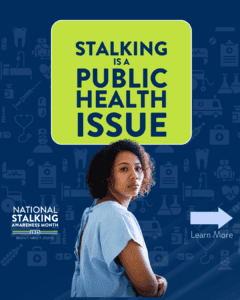In addition to January being National Human Trafficking Awareness Month, this month is also National Stalking Awareness Month. Both trafficking and stalking are major crimes that often disproportionately impact our Native communities and intersect with sexual violence. We know that, unfortunately, Native women are stalked at extremely high rates: approximately 48.8% of American Indian/Alaska Native women have experienced stalking in their lifetime. This signifies an extremely urgent public health crisis, because that means that almost half of our female relatives have been stalked.
Stalking is also known to lead to greater risk for a victim to experience further violence. Stalking after separating from an intimate partner leads to an increase in violence, and there is a significant connection between stalking and intimate partner homicide: stalking increases the risk of intimate partner homicide by three times. Perpetrators of stalking are also known to engage in sexual violence against their victims:
- 31% of women stalked by an intimate partner were also sexually assaulted by that partner
- Women stalked by a violent partner after obtaining a protective order were 9.3 times more likely to experience sexual assault than women with protective orders who were not stalked
- The threat of sexual violence is also often a tool used by stalkers, and it might look like: Secretly taking photos or videos of a victim
- Unwanted sexual communication (texts, emails, voicemails, etc. of a sexual nature)
- Sending unwanted sexual images
- Blackmailing a victim with or for sexual images, sexual activity, etc.
- “Revenge porn” or the distribution of sexual images without the victim’s consent
Stalking is often a co-occuring form of violence, both with sexual violence and domestic violence, yet according to anecdotal information we have heard from Tribal communities and Indigenous survivors across the country, even less prosecuted. Stalking can be a red flag or precursor to sexual violence, or a form of retaliation after an assault. Communities and programs need to learn more about the issues as well as help name and de-mystify stalking, so that survivors feel more comfortable disclosing and have information needed to document or safety plan if they are being stalked.
It is also important to work with systems to see how stalking can help enhance or be investigated and charged on its own for those survivors seeking justice through the criminal legal system. Learn more about stalking response considerations when working with Native communities in this resource MIWSAC worked collaboratively on.
While the focus of the National Tribal Sexual Assault Resource Center is sexual violence, our goal is to support communities in bringing education, working to prevent, and strengthening responses to all forms of intersecting violence. We also recognize that while distinct services are important, advocates and others need to be informed on all forms of violence to best support survivors. Our lives are not segmented out and the complex and compounding impacts of violence and trauma live out in each survivor in different ways (as well as the different ways people have learned to cope and heal from the violence).
We would love to work with your communities both to learn from your experiences and to increase communities’ capacity to support survivors in ways that best serve you! Contact us at [email protected] to connect.


